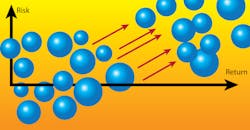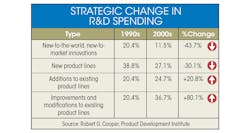Download the PDF version of this article.
For the past decade, which translates into two to five product cycles for most industries, broad-based innovation has been on the decline. The research of Dr. Robert Cooper, the creator of Stage-Gate, indicates that companies typically spent almost 60% of R&D funds on New-to-the-World, New-to-the-Market, and New Product Lines. The remaining 40% went to Additions to Existing Product Lines and Improvements to Existing Products. These figures are now inverted. Most companies now focus on extending the life of existing products and assets, and they will until GDP clearly outpaces inflation again. There are now indications that top-line pressures may lessen in a year. Let’s get a jump on likely good news by revisiting the alternatives companies have to spur innovation.
Just about everything companies do to innovate falls into six groups: Basic Research, Applied Research, Advanced Development, Product Development, Product Enhancement, and Product Invention. The first five categories are a continuum of capabilities and/or technologies progressing from the nascent to the mature. Product Invention, aka Skunk Works and other names, spans nascent to mature by itself.
In Basic Research (BR), discovery targets are broad. Scientists and researchers look for capabilities that have “some efficacy” with an articulated broad market or targeted need. Some BR is truly blue sky, but that has decreased over the past few decades as few can afford it. BR often just rules out what won’t work and identifies technologies or capabilities that might work.
Applied Research (AR) typically has a more specific target. There is some known problem, opportunity, or application area in which there is a possible economic gain or social improvement. AR picks up by taking things that might work and attempts to narrow down the feasible technical alternatives.
Advanced Development (AD) takes the feasible technical alternatives and culls out those with the best balance of performance and economics for achieving a target capability or feature that could be incorporated into products in Product Development. Clear lines of purpose begin to blur a bit in AD. Some companies use their Advanced organization to also fully develop New-To products. Skunk Works development is often an offshoot of AD organizations with commercial product developers added in.
Product Development (PD) integrates feasible, risk-reduced, and economically viable features and capabilities into products with both form and function for release to the marketplace. Smaller companies tend to not segregate their invention resources into these four groups to avoid extra overhead. Larger companies are increasingly doing so because the nature of the skill sets of scientists and engineers in BR/AR/AD are quite different, and really do need focused nurturing and management when the resource pools grow large.
The Venn diagrams of each of the above four progressive R&D categories always overlapped, but the overlaps have grown significantly in recent years. Research is needed to determine whether this increased overlapping has led to better corporate output and productivity, but managers continue to take advantage of plunking projects into places where they spot available capacity.
Product Enhancement (PE) is the jack-of-all-trades category. It has many purposes, focused on products that already exist: new compliance and regulations, performance enhancement/improvement, cost reduction, derivative applications/capabilities, incremental modifications for new geographies, and redesigns to replace obsoleted components, to name a few.
Product Invention (PI) is the soup-to-nuts category. Its purposes are narrow and typically focused on products emanating from a specific technology or the end-to-end creation of a new product or line. Resources are pulled from all R&D organizations and dedicated to the task.
As global economics mandated strategies to enhance utility, extend life, and reduce costs of existing products this past decade, historically moderate-sized PE groups grew quite large, became the end game, and BR/AR/AD investments shrunk. As more broad-based innovation begins to make a return, it will be necessary to rebalance portfolios and resources—and it typically takes a few years to get this right.
About the Author
Bradford Goldense
Contributing Technical Expert
Bradford L. Goldense is founder and president of Goldense Group, Inc. [GGI] (www.goldensegroupinc.com), a consulting, market research, and education firm focused on business and technology management strategies and practices for product creation, development, and commercialization. He has been an adjunct faculty member of the graduate engineering school at Tufts University's Gordon Institute for 19 years. Goldense is a Certified New Product Development Professional [NPDP], a Certified Manufacturing Engineer [CMfgE], a Certified Computer Professional [CCP], and is Certified In Production & Inventory Management [CPIM]. He holds over 200 registered copyrights and is a recognized subject-matter expert, including appearances on PBS and CNBC. He has consulted to over 250 companies and over 750 manufacturing locations on four continents since founding GGI in 1986. Goldense holds an MBA in Accounting from the Cornell Johnson School and a BSCE from Brown University. For more information, please see Brad's LinkedIn profile or visit GGI's home page.


